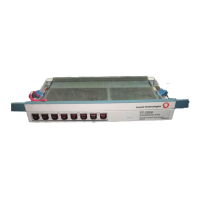TAP-115: Trouble Clearing 365-575-102
Page6of8 Issue8.0,July2002
NOTE:
The OC3/OC12 auto switch at near end or the OC3/OC12 auto
switch at far end may be associated with a condition on the OC-3/OC12
line or at the distant network element located at the other end of the OC-3/OC12
line (FT-2000 or DDM-2000).
NOTE:
Conditions are shown in the Description column of the Active Alarms and
Status Report.
29. Is there one or more other conditions with the same slot Source Address
in the report?
If YES, then continue with Step 30.
If NO, then continue with Step 32.
NOTE:
While following the instructions in the procedure(s) to which you will now be
sent, you MUST ignore the OC3/OC12 auto switch at near end and/or
OC3/OC12 auto switch at far end condition in the Active Alarms and
Status Report. For example, if you are asked whether there are any alarm or
status conditions listed and the only condition shown in the report is OC3/OC12
auto switch at near end and/or OC3/OC12 auto switch at far
end, the answer is NO.
NOTE:
After clearing the other condition identified in Step 29, continue the trouble
clearing procedure using TAP-102 at the network element that initially reported
the OC3/OC12 auto switch at near end and/or OC3/OC12 auto
switch at far end condition.
30. Find the condition identified in Step 29 in Table A of TAP-102 andgotothe
indicated TAP to clear that condition (ignoring the OC3/OC12 auto switch
at near end and/or OC3/OC12 auto switch at far end condition
throughout the remainder of the trouble clearing procedure).
31. STOP! YOU HAVE COMPLETED THIS PROCEDURE.
32. Do you have maintenance responsibilities for the network element at the other
end of the OC-3/OC12 line?
If YES, then continue with Step 34.
If NO, then issue a Trouble Report to the network element stating the error
condition you are receiving.

